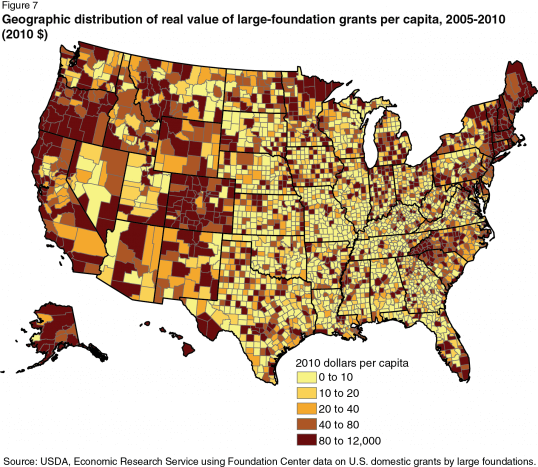 Image: Blog hero Plant Plate 09 boys dig in
Image: Blog hero Plant Plate 09 boys dig in
Is rural stuck in a philanthropic catch-22?

by Blandin Foundation Posted in Vibrant Rural
Last month, The Daily Yonder reported on a new USDA study that looks at the distribution of grant dollars between urban and rural. The results looked at all types of funding (not just development) and was based on data from the nation’s 1,200 to 1,400 largest foundations.
What did they find out? Here are some highlights from the Daily Yonder article:
- Whichever way you slice it, rural communities aren’t getting a proportionate share of foundation grants compared to the relative size of the rural population.
- Grants from large foundations to organizations based in rural areas came to about $88 per capita. Organizations in metropolitan areas received foundation support at twice that per capita rate.
- Rural grants are more likely to go to education, environmental protection, and recreation that urban grants. Conversely, rural organizations are less likely than urban ones to receive grants to support arts and cultural activities, philanthropy and volunteerism, and medical research.
Capacity to administer grants was one reason cited explaining the imbalance between rural/urban funding. While developing nonprofit and educational capacity would seem like a logical answer, it lands rural communities in a bit of a catch-22. Report author John L. Pender writes,
Since foundation funds (and other sources of funds) are often important to develop these capacities, this illustrates circularity in the process of community development—funds are needed to develop local capacity, which is needed to raise funds.
While USDA’s research offers new data and perspectives, the uneven distribution of philanthropic dollars between urban and rural is not a new idea. Nonprofit Quarterly writer Rick Cohen has been covering national conversations about rural philanthropy for years. He’s covered a number of efforts, from the proposed Rural Philanthropy Growth Act to recommendations coming out of the National Rural Assembly, but, as USDA’s report spells out, the work is far from done.
For that reason, Blandin Foundation is exploring with other foundations how the voices of rural communities might better show up in the world of philanthropy. If you are interested in joining an emerging network of foundations that work in, and care about, rural, email Blandin Foundation president Dr. Kathleen Annette at kathy.annette@blandinfoundation.org.